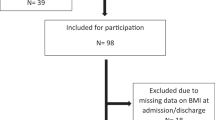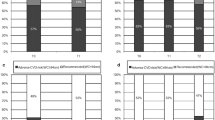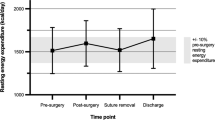Abstract
Study design:
Retrospective chart review.
Objective:
To identify the prevalence of overweight and severely overweight (obese) in veterans with spinal cord injury.
Setting:
Veterans Administration Hospital in Wisconsin.
Methods:
A retrospective chart review of all the patients registered in the current database with the Spinal Cord Injury Unit in the Veterans Administration Hospital was undertaken Data collected for each patient included age, sex, height, date of assessment of the height, weight, date of assessment of the weight, duration of spinal cord injury and the type of spinal cord injury – paraplegia versus quadriplegia. The body mass index (BMI) was subsequently calculated for each patient and the prevalence of overweight and obesity were determined.
Results:
There were a total of 408 patients registered in the database with the Spinal Injury Unit. The median age was 56 years, and the mean age 55.8 years. Of all patients with spinal cord injury, 52.2% patients had paraplegia and 47.7% had quadriplegia. The mean duration of injury was 19 years. Of the total number of patients, 46.0% were ASIA A, 11.0% were ASIA B, 12.7% were ASIA C and 29.1% were ASIA D. In all, 27.9% patients had a normal BMI and 3.6% patients were undernourished (BMI less than 18.5 kg/m2). The prevalence of overweight was 65.8% and 29.9% patients were obese.
Conclusion:
Overweight and obesity are problems of a significant magnitude in veterans with spinal cord injury.
Similar content being viewed by others
Introduction
Obesity is one of the most prevalent diet-related problems in the United States. It affects about 34 million adults with the highest rates in the poor and the minority groups. Obesity increases the risk for other diseases such as diabetes mellitus, hypertension, atherosclerosis and dyslipidemia.1, 2, 3 Obesity in people with spinal cord injury is associated with increased risk for sleep apnea and also thought to influence functional outcome and increase risk for injury in the nursing staff.4, 5, 6 In people with spinal cord injury the incidence of hypertension, diabetes mellitus and ischemic heart disease increases with increasing time since injury.7
Obesity or excess body fat is measured by different means and one of the most commonly used methods is to compute an index of body weight as a function of height and to compare this calculation to population standards, known as the body mass index (BMI). BMI estimates total body mass rather than fat mass, but it correlates highly with amount of body fat.1
In our analysis of the literature there is no data on the prevalence of overweight/obesity using BMI in this special population. The purpose of this study is to identify the magnitude of the problem of obesity in veterans with spinal cord injury.
Patients and methods
The study is a retrospective chart review of all the veterans registered in the current database with the Spinal Cord Injury Unit at the Clement J Zablocki Veterans Administration Hospital in Milwaukee. Data collected for each patient included age, sex, height, date of assessment of the height and weight, duration of spinal cord injury, type of spinal cord injury score – paraplegia versus quadriplegia and the ASIA (American spinal injury association) score. The BMI was calculated for each patient (BMI=weight (in kg)/ht2 (in meters)). The prevalence of overweight (proportion of patients with BMI of 25 kg/m2 or above) and severely overweight or obese (proportion of patients with BMI of 30 kg/m2 or more) in the study population was determined using the calculated BMI. The protocol for the study was approved by the local Institutional Review Board.
Results
There were a total of 408 patients with a diagnosis of spinal cord injury in the database with the Spinal Cord Injury Unit at the Milwaukee Veterans Administration Hospital. There were 401 (98.28%) male patients and seven (1.72%) female patients. The demographic characteristics of the study population are shown in Table 1. The median age was 56 years, and the mean age 55.84 (age range 21–85 years). Of all patients with spinal cord injury, there were 213 (52.21%) patients with paraplegia and 195 (47.79%) with quadriplegia. The mean duration of injury was 19 years (range: 2 months–60 years). Of the total number of patients, 188 (46.08%) were ASIA A, 45 (11.03%) were ASIA B, 52 (12.75%) were ASIA C and 119 (29.17%) were ASIA D.
Data relevant to measure the BMI were unavailable for 21 patients; therefore, 387 patients were included in the analysis. A total of 108 (27.91%) patients had a normal BMI (BMI=20–25 kg/m2) and 14 (3.62%) patients were undernourished (BMI less than 18.5 kg/m2). A total of 255 (65.89%) patients had BMI's in the overweight or the severely overweight category. The prevalence of overweight and obesity by age, ASIA Score and Type of Injury is shown in Tables 1 and 2, respectively. The patients with paraplegia had a mean BMI of 28.36 kg/m2, while the patients with quadriplegia had a mean BMI of 27.29 kg/m2 and this difference was statistically significant (P<0.5). The distribution of average BMI in relation to the ASIA score and the duration of injury is shown in Tables 3 and 4, respectively.
Discussion
There were 98.28% male subjects in our study population compared to 81.2% in the national database. Our study sample consists of veterans and a higher male to female ratio is expected. The distribution of the population in regards to the type of injury and ASIA score almost matches the national database.8
Obesity is the most prevalent nutrition related problem in the United States and over the past 20 years it has risen at an epidemic rate. In all, 64% of the adults above 20 years of age in the United States are either overweight or obese, defined as having a BMI of 25 or more.9 The same study also reported that 30.5% of these adults were obese, defined as a BMI of 30 or more. In our study, the prevalence of overweight and obesity matches the national data or maybe marginally higher with 65.89% of patients with spinal cord injury being either overweight or obese and 29.97% obese, defined by the same criteria.
The age-specific prevalence rate also indicates a high prevalence of overweight and/or obesity in almost all age groups and tends to match the national population.9 The sample size of our population between the ages of 20 and 39 years was too small to accurately measure the prevalence and a larger sample is required to confirm the results. The prevalence of overweight and/or obesity (BMI of 25 kg/m2 or more) was significantly higher in paraplegics versus the quadriplegics and this trend was visible at all ASIA levels except ASIA A category. In spite of a greater expectation of exercise and mobility in paraplegics and the presence of low levels of physical activity,10 the reason for this apparent difference is highly speculative with the ability to use both upper limbs giving increased independence to eat freely. The quadriplegics on the other hand may have to depend on a caregiver for a simple activity such as eating and may be limited in the amount of food at each mealtime. A larger sample may be needed to confirm or dispute the apparent finding. Similarly the prevalence of obesity (BMI of 30 kg/m2 or more) was equally higher in paraplegics versus the quadriplegics amongst all ASIA levels.
Obesity and overweight increase the risk for cardiovascular disease, diabetes mellitus and certain cancers.2, 4 The incidence of cardiovascular diseases and diabetes increases in patients with spinal cord injury with increasing time.3 This study is an attempt to collect data, identify the magnitude of the problem so that primary prevention strategies could be implemented to reduce the incidence for the same and improve physical quality of life for such patients.
BMI is the most frequently used measure of excess body fat and correlates significantly with the body fat.1 In patients with spinal cord injuries, BMI may underestimate the amount of body fat and many patients may not appear obese yet carry large amounts of adipose tissue.11 This may skew the results and existing body mass index values only approximate the magnitude of the problem, which in fact may be higher than what our study reveals.
Conclusion
Overweight and obesity are significant problems in veterans with spinal cord injury. The prevalence of obesity is similar to that as in the general population in the United States. Overweight and obesity increase the risk for cardiovascular diseases like hypertension and ischemic heart disease and metabolic diseases like diabetes mellitus. The potential benefits of reduction in the magnitude of this problem cannot be overemphasized and further studies are warranted to ascertain the impact of the problem on functional skills and not just medical diseases.
Note
-
1
Statistical analysis was not performed on Tables 3 and 4. The future goal of our study is to detail and correlate this prevalence of overweight and obesity with duration of injury and with increasing age.
-
2
We have only attempted to determine the prevalence of obesity and overweight in relation to duration of injury and not correlate it with that. We are of the opinion that possibly a greater number of patients may be needed to arrive at a clinically useful correlation.
-
3
Our study is to determine the prevalence with a future goal to also determine correlations with duration of injury, age and other factors as may be relevant.
References
The Surgeon General's Report on Nutrition and Health. US Department of Health and Human Services Public Health Service Publication 88-50210, 1988.
Ernst ND, Obarzenek E, Clark MB, Briefel RR, Brown CD, Donato K . Cardiovascular health risks related to overweight. J Am Diet Assoc 1997; 97(Suppl): S4751.
Brown CD et al. Body mass index and the prevalence of hypertension and dyslipidemia [see comment] [Journal Article]. Obes Res 2000; 8: 605–619.
Brentin L, Sieh A . Caring for the morbidly obese. Am J Nurs 1991; 91: 40–43.
Hudelson E . Points to remember when caring for an obese patient. Nursing 1992; 22: 62–63.
Blackmer J, Marshall S . Obesity and spinal cord injury: an observational study. Spinal Cord 1997; 35: 245–247.
Yekutiel M, Brooks ME, Ohry A, Yarom J, Carel R . The prevalence of hypertension, ischemic heart disease and diabetes in traumatic spinal cord injured patients and amputees. Paraplegia 1989; 27: 58–62.
National Spinal Cord Injury Statistical Center. Facts and figures at a glance, 2003 National Spinal Cord Injury Statistical Center. Birmingham, Alabama, Available online at. www.spinalcord.uab.edu.
Flegal KM, Carroll MD, Ogden CL, Johnson CL . Prevalence and trends in obesity among US adults, 1999–2000. JAMA 2002; 288: 1723–1727.
Buchholz AC, McGillivray CF, Pencharz PB . Physical activity levels are low in free-living adults with chronic paraplegia. Obes Res 2003; 11: 563–570.
Jones LM, Legge M, Goulding A . Healthy body mass index values often underestimate body fat in men with spinal cord injury. Arch Phys Med Rehab 2003; 84: 1068–1071.
Author information
Authors and Affiliations
Rights and permissions
About this article
Cite this article
Gupta, N., White, K. & Sandford, P. Body mass index in spinal cord injury – a retrospective study. Spinal Cord 44, 92–94 (2006). https://doi.org/10.1038/sj.sc.3101790
Published:
Issue Date:
DOI: https://doi.org/10.1038/sj.sc.3101790
Keywords
This article is cited by
-
Obesity in wheelchair users with long-standing spinal cord injury: prevalence and associations with time since injury and physical activity
Spinal Cord (2024)
-
Sleeve gastrectomy as a bridge to maternity in a patient with obesity, infertility and tetraplegia. A case report
Spinal Cord Series and Cases (2024)
-
Correlates of metabolic syndrome in people with chronic spinal cord injury
Journal of Endocrinological Investigation (2024)
-
A national survey of physical activity after spinal cord injury
Scientific Reports (2022)
-
Changes in body composition during and after inpatient rehabilitation in people with recent spinal cord injury
Spinal Cord Series and Cases (2021)



